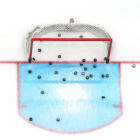
With all of the things coaches and general managers already have to worry about in a contact sport like hockey, from injuries to suspensions, they probably never figured on mumps being something to even think about. However, since late October, the fear of players contracting the highly-contagious ailment has been very real.
As of Wednesday, 12 players have been confirmed to have contracted the mumps with four teams affected including the Minnesota Wild, Anaheim Ducks, New York Rangers and New Jersey Devils. Additonally, the St. Louis Blues dealt with illness sweeping the team in October that was then simply described as a bacterial infection, but had symptoms consistent with mumps. Additionally, two on-ice officials have been diagnosed with mumps according to the Canadian Press.
The Wild have been hit hardest so far with five defensemen confirmed to have contracted the virus. That led to 24 man games lost, including two from workhorse defenseman Ryan Suter. Meanwhile, the Anaheim Ducks lost two of their most important players in Corey Perry and Francois Beauchemin at the same time.
The Devils were the latest team hit with the mumps as both forward Travis Zajac and defenseman Adam Larsson were found to have contracted the disease about a week after getting tested for it. That became public Tuesday.
From the Centers for Disease Control and Prevention:
Mumps is a contagious disease that is caused by the mumps virus. Mumps typically starts with a few days of fever, headache, muscle aches, tiredness, and loss of appetite, and is followed by swelling of salivary glands. Anyone who is not immune from either previous mumps infection or from vaccination can get mumps.
Mumps is spread by droplets of saliva or mucus from the mouth, nose, or throat of an infected person, usually when the person coughs, sneezes, or talks. Items used by an infected person, such as soft drink cans or eating utensils, can also be contaminated with the virus, which may spread to others if those items are shared. In addition, the virus may spread when someone with mumps touches items or surfaces without washing their hands and someone else then touches the same surface and rubs their mouth or nose.
Mumps symptoms can vary greatly from person to person. Ducks star Corey Perry was briefly hospitalized, Wild defenseman Keith Ballard missed eight games, Ryan Suter missed only a pair, while Devils forward Travis Zajac was already over the illness after he was confirmed to have had the mumps.
| Confirmed Mumps Cases in the NHL | |||
| Player | Team | Games Missed | |
| Keith Ballard | Minnesota Wild | 8 | |
| Christian Folin | Minnesota Wild | 5 | |
| Jonas Brodin | Minnesota Wild | 7 | |
| Corey Perry | Anaheim Ducks | 5 | |
| Francois Beauchemin | Anaheim Ducks | 5 | |
| Clayton Stoner | Anaheim Ducks | 5 | |
| Marco Scandella | Minnesota Wild | 2 | |
| Ryan Suter | Minnesota Wild | 2 | |
| Emerson Etem | Anaheim Ducks | 0* | |
| Travis Zajac | New Jersey Devils | N/A^ | |
| Adam Larsson | New Jersey Devils | 4^ | |
* - Sent down to AHL before diagnosis; ^ - Remains out, Zajac was out with an injury prior to diagnosis and hasn't played since Nov. 28, but is expected to return soon.
While what is happening in the NHL may not be considered a full on outbreak, the fact that mumps is hitting such a defined group of individuals is cause for concern and it’s also brought about some finger-pointing.
The reality is that there’s probably not a lot that could have been done to prevent this disease from sweeping the league and even as more distance is put between now and when the first case was reported, mumps’ impact on the NHL could persist.
Dr. Greg Wallace, who is the domestic lead on mumps, measles, rubella and polio for the Centers for Disease Control and Prevention, expressed that the unpredictability of mumps as well as the limitations of the vaccine against the virus makes it difficult to predict what comes next.
“Mumps is a little bit challenging for us in that the effectiveness of the vaccine is a little bit lower for some of the other diseases,” Wallace told CBSSports.com. “We do occasionally see some limited outbreaks in groups that tend to have a high two-dose vaccine coverage. The virus can out-compete the vaccine.”
Vaccinations have not been able to wipe out mumps like they have other viruses, so exposure to the virus still leaves those at risk.
“If you have a team and their staff consists of 100 people and they all get exposed,” Dr. Wallace said, ”you could have 10, 12, 15 cases even if everyone is vaccinated. “
Dr. Wallace also noted that if the NHL didn’t have high vaccine coverage, there would have already been a lot more cases of the mumps reported.
The unpredictability of the disease also makes it difficult to trace back to the origin, according to Dr. Wallace. Anaheim has widely been speculated as the source of the initial exposure, but that may be impossible to find out for sure.
Wallace did express mild surprise that the disease had ended up jumping from team to team.
“We have seen it with some teams, sharing water bottles and are in close quarters,” he said. “But to have it skipping a couple few teams like this is happening, I do wonder a little bit what it is about either the game itself -- it’s very fast moving and is a contact sport, but not prolonged contact -- as well as how much these players [on opposing teams] interact outside of the games."
The NHL has been monitoring the situation closely since the beginning, but there's not a lot the league can do to thwart the spread of mumps throughout its locker rooms. Much of that is up to the individual teams, many of which have already started taking precautions.
On the league level, they’re doing really the only thing they can, which is to provide as much information to the member clubs as possible.
According to an NHL spokesman, the league sent out comprehensive instructions to team physicians and head athletic trainers from its Infection Control Subcommittee in mid-November. The NHL also reiterated its recommendations on locker room and bench behavior that are standard precautions they already advise regarding the flu, but detailed them again anyway.
The league also provided the teams with information about providing vaccinations, but the decision regarding administering the vaccines is left up to the team medical personnel and players themselves.
Dr. Wallace noted that even if players have received their recommended two doses of the MMR vaccine, and most players would be at an age where they would have, a third dose of the vaccine can be administered.
“[An extra vaccine dose] may provide some additional protection,” he explained. “We just haven’t been able to prove that statistically."
There’s only so much players can do after they’ve already been exposed, though. Mumps has an incubation period of 12-25 days according to Dr. Wallace, thus delaying the awareness that a player even has it. Additionally, individuals with the virus can become contagious days before they ever show any symptoms.
Wallace says that the best thing teams can do at this point is keep players away as soon as they start showing symptoms, even though it may already be too late to avoid others being exposed.
It is going to be very difficult to predict when this will have run its course and when the league can finally breathe a sigh of relief. Until then, teams can only take as many precautions as possible and hope for the best.
![[object Object] Logo](https://sportshub.cbsistatic.com/i/2020/04/22/e9ceb731-8b3f-4c60-98fe-090ab66a2997/screen-shot-2020-04-22-at-11-04-56-am.png)

















